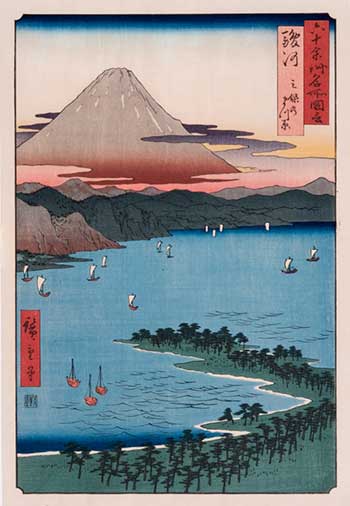Tom on Japan
Hokusai and Mt. Fuji - Part II
Part II
Hokusai and Mt. Fuji
The Great Wave and the White Whale

And for good reason. The Great Wave is a world-class contribution to art which illustrates the eternal struggle of humankind with nature. So let’s take a look at this masterpiece.
You’ll immediately notice the intense Prussian blue in the wave, which contrasts wonderfully with white foam. Next look at the three cargo boats (which are bringing fresh seafood to Edo). In Hokusai’s Mount Fuji, author Jocelyn Bouquillard points to those hapless boats as a metaphor for ukiyo itself - the ephemeral floating world of Buddhist belief and Edo life. Please see our review of this book under Book Reviews - Art - Hokusai.
The great wave as a force of nature threatens boats and men. But Hokusai doesn’t stop there. He breathes life into the insensate, perilous wave, animating it with menacing claws - leaving little hope for those sailors about to plunge into the deep.
Now contrast the unmoving mass of the great mountain with the fluid wave. Mt. Fuji itself may be immovable yet the silent, snow capped mountain is in fact linked to the roiling, foaming sea - by white pigment. Two color blocks would not have been necessary - the same white unites mountain and sea.
In Japan among other Asian cultures white is associated with death and mourning, particularly at Buddhist funerals. Yet so is white inauspicious in the great American novel Moby Dick, where Herman Melville devotes an entire chapter to “The Whiteness of the Whale”.
That chapter was just a point of departure for Melville to explore what he considered the noxious nature of white, known to sailors caught up in the “White Squall” of the Southern Seas, and to the whale ship Pequod, stove and sunk by a white whale. Even Mt. Fuji blanketed in white snow was matched by the “gigantic ghostliness over the soul” of New Hampshire’s White Mountains when “in peculiar moods”.
Moby Dick was published in 1851; The Great Wave in 1831, before Japanese prints began making their way to America or Europe in a big way. So it’s unlikely Hokusai’s Wave influenced Melville. But maybe the sorrow (or worse) of white, noted by artist and writer working nearly 7000 miles and 20 years apart, is universal. Might make an intriguing thesis for the right student.
100 Views of Mt. Fuji
We can’t leave the subject of Hokusai and Mt. Fuji without saying something about this series, which was published in book form rather than as individual prints. The first of its three volumes quickly followed the 36 Views, and was published in 1834. The final volume appeared sometime in the late 1840s.
The first thing you notice flipping through these sketches is that unlike the 36 Views, they aren’t in color, though it’s not entirely correct to say they‘re black and white.

Fuji at Sea
The original edition, reproduced in the 100 Views recommended in our book reviews, was printed in sumi (black) ink which was then diluted to gray in parts of the design.
So black, white, and gray are the result. Why the absence of color? The complete 102 designs (two “extras” thrown in) if printed in color would have been ruinous for Hokusai’s publisher. Japan in the mid-1830s was wracked by famine - with dire economic consequences.
The 36 Views outdoes its successor series for accuracy portraying actual scenery in Fuji’s vicinity. But literal accuracy wasn’t a major concern for Hokusai just as it was not for the Impressionists who admired him. So what we get instead is a display of his enormous imaginative range.
Mt. Fuji is the unifying thread in both series but you wouldn’t always think so. Sometimes the mountain is the clear focus of attention, other times it’s people going about their business, or wonderful animals doing their thing. Still other times the mountain is a distant backdrop subsumed in foreground landscape.
Pick a half dozen designs at random to see why the 100 Views easily establishes Hokusai’s genius for draftsmanship. Since we’re not distracted by color, this element takes on fundamental importance. It’s also the reason many who write about Hokusai consider this series his greatest achievement.
©2018 Tom Silver

